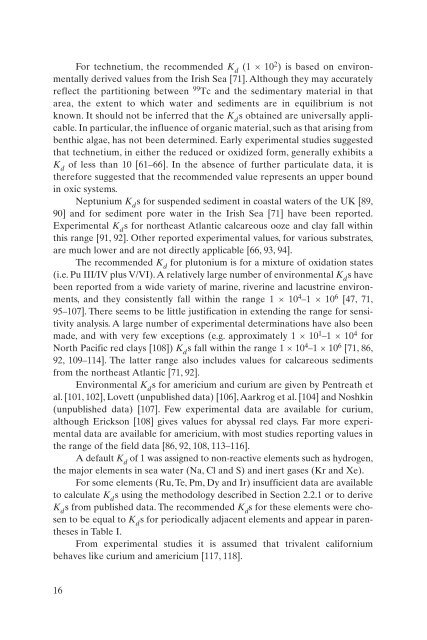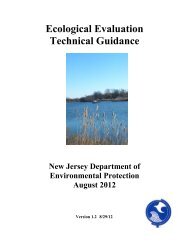Sediment Distribution Coefficients and Concentration Factors for ...
Sediment Distribution Coefficients and Concentration Factors for ...
Sediment Distribution Coefficients and Concentration Factors for ...
Create successful ePaper yourself
Turn your PDF publications into a flip-book with our unique Google optimized e-Paper software.
For technetium, the recommended K d(1 × 10 2 ) is based on environmentallyderived values from the Irish Sea [71]. Although they may accuratelyreflect the partitioning between 99 Tc <strong>and</strong> the sedimentary material in thatarea, the extent to which water <strong>and</strong> sediments are in equilibrium is notknown. It should not be inferred that the K ds obtained are universally applicable.In particular, the influence of organic material, such as that arising frombenthic algae, has not been determined. Early experimental studies suggestedthat technetium, in either the reduced or oxidized <strong>for</strong>m, generally exhibits aK dof less than 10 [61–66]. In the absence of further particulate data, it isthere<strong>for</strong>e suggested that the recommended value represents an upper boundin oxic systems.Neptunium K ds <strong>for</strong> suspended sediment in coastal waters of the UK [89,90] <strong>and</strong> <strong>for</strong> sediment pore water in the Irish Sea [71] have been reported.Experimental K ds <strong>for</strong> northeast Atlantic calcareous ooze <strong>and</strong> clay fall withinthis range [91, 92]. Other reported experimental values, <strong>for</strong> various substrates,are much lower <strong>and</strong> are not directly applicable [66, 93, 94].The recommended K d<strong>for</strong> plutonium is <strong>for</strong> a mixture of oxidation states(i.e. Pu III/IV plus V/VI).A relatively large number of environmental K ds havebeen reported from a wide variety of marine, riverine <strong>and</strong> lacustrine environments,<strong>and</strong> they consistently fall within the range 1 × 10 4 –1 × 10 6 [47, 71,95–107]. There seems to be little justification in extending the range <strong>for</strong> sensitivityanalysis. A large number of experimental determinations have also beenmade, <strong>and</strong> with very few exceptions (e.g. approximately 1 × 10 1 –1 × 10 4 <strong>for</strong>North Pacific red clays [108]) K ds fall within the range 1 × 10 4 –1 × 10 6 [71, 86,92, 109–114]. The latter range also includes values <strong>for</strong> calcareous sedimentsfrom the northeast Atlantic [71, 92].Environmental K ds <strong>for</strong> americium <strong>and</strong> curium are given by Pentreath etal. [101, 102], Lovett (unpublished data) [106],Aarkrog et al. [104] <strong>and</strong> Noshkin(unpublished data) [107]. Few experimental data are available <strong>for</strong> curium,although Erickson [108] gives values <strong>for</strong> abyssal red clays. Far more experimentaldata are available <strong>for</strong> americium, with most studies reporting values inthe range of the field data [86, 92, 108, 113–116].A default K dof 1 was assigned to non-reactive elements such as hydrogen,the major elements in sea water (Na, Cl <strong>and</strong> S) <strong>and</strong> inert gases (Kr <strong>and</strong> Xe).For some elements (Ru, Te, Pm, Dy <strong>and</strong> Ir) insufficient data are availableto calculate K ds using the methodology described in Section 2.2.1 or to deriveK ds from published data. The recommended K ds <strong>for</strong> these elements were chosento be equal to K ds <strong>for</strong> periodically adjacent elements <strong>and</strong> appear in parenthesesin Table I.From experimental studies it is assumed that trivalent cali<strong>for</strong>niumbehaves like curium <strong>and</strong> americium [117, 118].16
















